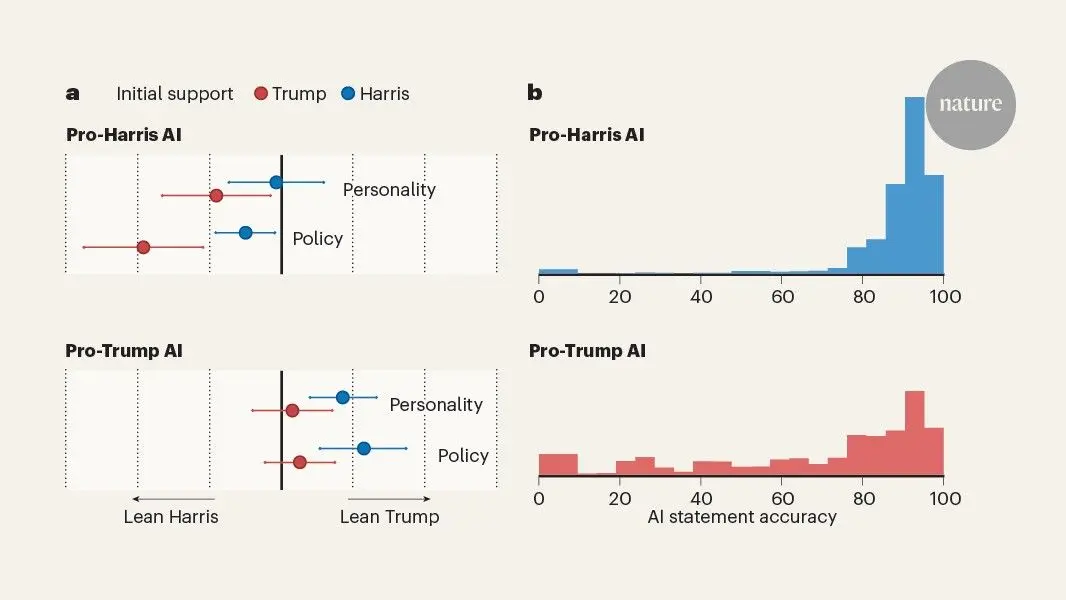GroceryDB: AI-Powered Database Helps Consumers Navigate Ultra-Processed Foods
3 Sources
3 Sources
[1]
GroceryDB helps shoppers spot ultra-processed foods
By Priyanjana Pramanik, MSc.Reviewed by Lily Ramsey, LLMJan 15 2025 A 50,000-item database uncovers processing levels and healthier alternatives for smarter choices. Study: Prevalence of processed foods in major US grocery stores. Image Credit: CandyRetriever/Shutterstock.com In an article in Nature Food, researchers analyzed data from over 50,000 products across American grocery stores to create an open-source, detailed database of information on pricing, ingredients, and nutritional value. This database highlights the utility of machine learning methods to support public health efforts, inform consumer choices, promote access to nutritional information, and improve dietary and health outcomes. Background The rise in ultra-processed foods (UPFs) has improved food availability and shelf life but at the cost of health and sustainability. Evidence shows that UPF consumption, which comprises nearly 60% of calories across developed countries, may increase non-communicable diseases like metabolic syndrome and exposure to harmful preservatives and pesticides. This has shifted focus from food security to nutrition security, emphasizing access to affordable, healthy, and safe food. However, despite UPFs being widely consumed, determining the degree of processing is challenging due to inconsistent classification systems and ambiguous food labels. Current methods lack reliability and reproducibility, leading to varied interpretations of UPFs' health risks. Researchers call for objective, biological, mechanism-based metrics to classify food processing accurately. Artificial intelligence (AI) offers promising solutions by creating data-driven and objective tools. A recent development is the food processing (FPro) score, an automated index using machine learning to classify food processing based on nutrient profiles. FPro leverages the NOVA classification system and other frameworks, providing reliable and scalable metrics to enhance nutrition security and support Sustainable Development Goals like zero hunger and improved health. This innovative approach could transform how we assess and manage food processing's impact on health. About the study Food data was gathered from online platforms of major American grocery chains. These stores categorize food items hierarchically, and this structure was standardized across the database. Nutrition information was sourced from product labels, converted to a uniform measure (per 100g), and analyzed using the FoodProX algorithm to assess food processing levels. A machine learning tool was used to evaluate nutrient changes caused by processing to assign an FPro score from 0 (unprocessed) to 1 (ultra-processed). The algorithm was trained on known classifications (NOVA) and validated food processing effects on nutrients. Ingredient lists were ranked by quantity, helping calculate the ingredient FPro (IgFPro) score, which links ingredient amounts to processing levels. The database contains detailed food and ingredient data in spreadsheet files, providing FPro scores, nutritional information, and ingredient processing scores. A substitution algorithm offers processed food alternatives by analyzing ingredient and food name similarities and sorting suggestions by FPro score. Findings The study utilized the FPro system to assess the processing levels of various food items by translating their nutritional content into a processing score. For instance, organic multigrain bread, produced from whole grains without additives, had a lower processing score of 0.314), while more processed bread had higher scores due to added fibers and starches (0.732 and 0.997 respectively). Similarly, yogurts made from organic milk had a low processing score (0.355), while others with added sugars and additives had a higher score (0.918). Analysis of processing levels across major grocery store chains revealed that ultra-processed items dominated store inventories. However, while some offered more minimally processed options, others had a higher proportion of ultra-processed foods. Researchers also found variability in processing levels within food categories, like cereals and snack bars, indicating diverse consumer choices in some categories. Additionally, a 10% increase in food processing generally led to an 8.7% decrease in the price per calorie, though this varied by food type. For example, highly processed soups were significantly cheaper per calorie than minimally processed ones. This highlights the complex relationship between food processing, cost, and consumer choices. Conclusions This open-source database provides information and tools to analyze food processing and ingredient structures in the U.S. grocery market. Integrating large-scale food composition data and machine learning reveals varying levels of food processing across different grocery stores. Factors like food costs, consumer socioeconomic status, and supermarket missions influence these differences. The platform highlights the link between food processing and affordability, with lower-income populations consuming more processed foods, which impacts nutrition security. Governments increasingly recognize the health costs associated with processed foods, such as obesity-related medical expenses. This database offers insights into food processing levels, helping consumers make healthier choices by translating complex data into actionable scores. Despite challenges in interpreting food labels, this system can guide better dietary decisions and public health strategies, like reorganizing store layouts. The FPro algorithm evaluates food processing through nutrient concentrations but aims to improve by incorporating more comprehensive ingredient data, ultimately enhancing its reliability and consumer guidance. Journal reference: Ravandi, B., Ispirova, G., Sebek, M., Mehler, P., Barabási, A., Menichetti, G. (2025) Prevalence of processed foods in major US grocery stores. Nature Food. doi: 10.1038/s43016-024-01095-7. https://www.nature.com/articles/s43016-024-01095-7
[2]
Database ranks 50,000 processed foods
By Dr. Priyom Bose, Ph.D.Reviewed by Danielle Ellis, B.Sc.Jan 14 2025 Researchers found that in some stores, highly processed foods were the only option in some categories A recent Nature Food study used machine learning techniques to analyze over 50,000 products from major US grocery store websites, developing the GroceryDB database, which facilitates consumer decision-making and informs public health initiatives. Quantifying the extent of food processing in grocery stores Research has shown the adverse health implications of reliance on ultra-processed food (UPF), which contributes up to 60% of total calorie intake in developed countries. Much of UPF reaches consumers through grocery stores, which motivates questions surrounding quantifying the extent of food processing in the food supply, methods to be used, and alternatives to reduce UPF consumption. Measuring the degree of food processing is not straightforward because food labels often contain mixed and unclear messages, leaving room for ambiguity and differences in interpretation. Therefore, scientists have been advocating for a more objective definition of the degree of food processing based on biological mechanisms. Furthermore, owing to the large-scale and complex data in question, artificial intelligence (AI) methodologies are increasingly being used to advance nutrition security. About the study Publicly accessible data on food products were compiled from the websites of the US's leading grocery stores, Walmart, Target, and Whole Foods. The websites were navigated to identify specific food items, and consistency was ensured by aligning the classification systems used by each store. The food labels were used to standardize nutrient concentrations, while FoodProX was used to assess each item's degree of food processing. FoodProX is a random forest classifier that translates the combinatorial changes in the quantities of nutrients affected by food processing into a food processing score (FPro). Extensive tests and validations on the stability of FPro were performed. The final score was contingent on the probability of observing the overall pattern of nutrient concentrations in unprocessed food as opposed to UPF. The price per calorie variation at various levels of food processing was computed using robust linear models with Huber's t-norm. Study findings Leveraging the machine learning classifier FoodProX, the GroceryDB database assigned an FPro score to all food items. Across all three supermarkets, the FPro distribution was similar, and the results suggested that low FPro foods (minimal processing) account for a relatively small fraction of grocery store inventory. Most items were in the high FPro or UPF category. The low FPro items account for a proportionally greater fraction of actual purchases, showing a mismatch between sales data and available food options. Some differences across stores were noted, i.e., Whole Foods offers fewer ultra-processed options, while Target offers a high proportion of high FPro food items. Low FPro variation was noted in categories like jerky, popcorn biscuits, mac and cheese, chips, and bread, highlighting limited consumer choice in these segments. This was not the case in other categories, such as cereals, pasta noodles, milk and milk substitutes, and snack bars, where consumers had more choices. Moreover, the distribution of FPro in GroceryDB and the latest USDA Food and Nutrient Database for Dietary Studies (FNDDS) was similar. Concerning the relation between price and calories, a 10% increase in FPro resulted in an 8.7% decrease in the price per calorie of products across all categories in GroceryDB. The food category was important in the relationship between FPro and price per calorie, with most processed foods likely being cheaper per calorie than the minimally processed alternatives. The relationship between milk and milk-substitute category and FPro showed an increasing trend. Regarding store heterogeneity in the same food category, the analysis showed that cereals sold at Whole Foods typically contain fewer artificial and natural flavors, less sugar, and fewer added vitamins relative to Walmart and Target. The brands offered by each store could also explain the heterogeneity, with Whole Foods relying on suppliers different from Target and Walmart. Some food categories, such as pizza, popcorn, and mac and cheese, are highly processed in all stores. As per GroceryDB, Whole Foods offers a wider FPro range of cookies and biscuits for consumers to choose from, whereas Target and Walmart have identical and narrower ranges of FPro scores. An ingredient FPro (IgFPro), ranging from 0 (unprocessed) to 1 (ultra-processed), was calculated to rank ingredients based on their contribution to the degree of processing of the final product. By analyzing a variety of food items, it was shown that not all ingredients contribute equally to the amount of processing, and food products with more complex ingredient lists tend to be more processed. Conclusions In summary, this work uses machine learning techniques to model the chemical complexity of food items offered by some leading supermarkets in the US. GroceryDB and FPro offer a data-driven approach for consumers to identify similar but less processed alternatives across a range of categories. Journal reference: Ravandi, B., Ispirova, G., Sebek, M., Mehler, P., Barabási, A., & Menichetti, G. (2025) Prevalence of processed foods in major US grocery stores. Nature Food, 1-13. https://doi.org/10.1038/s43016-024-01095-7
[3]
New tool lets you check how processed and unhealthy your food is - Earth.com
We all know processed food isn't the best thing on the plate. But how do we navigate the confusing language of food labeling? A remarkable tool now helps consumers and policymakers understand the processing levels of over 50,000 different items. Researchers from Mass General Brigham created this public database to promote informed food choices and advocate for better food regulation. Processed foods are those that have been altered from their natural state in some way, usually to make them last longer or taste better. This includes things like freezing vegetables, canning beans, or adding salt and sugar to bread. These changes can be pretty simple and often retain most of the original nutrients. For example, a jar of tomato sauce or a bag of roasted nuts are considered processed foods because they've been prepared or packaged, but they still contain ingredients you'd recognize and are generally healthy when eaten in moderation. On the other hand, ultra-processed foods go through much more extensive manufacturing and contain ingredients you wouldn't normally find in a home kitchen. These foods often include artificial colors, flavors, preservatives, and other additives designed to enhance taste, texture, and shelf life. Think of things like sugary cereals, sodas, packaged snacks, instant noodles, and frozen dinners. Ultra-processed foods are usually higher in unhealthy fats, sugars, and salt, and they tend to be lower in essential nutrients. Highly and ultra-processed foods make up a significant portion of what is available in most grocery stores. While they may be convenient or taste appealing, research has linked diets high in these types of foods to serious health issues, including obesity, diabetes, and heart disease. Despite growing awareness about the risks associated with these foods, many shoppers struggle to determine how processed a particular food item is. Ingredient labels and nutritional information can be overwhelming or unclear, making it difficult for the average consumer to make informed choices. "There are a lot of mixed messages about what a person should eat. Our work aims to create a sort of translator to help people look at food information in a more digestible way," said Dr. Giulia Menichetti, a lead researcher at Brigham and Women's Hospital. To address the challenge of understanding food processing levels, researchers applied machine learning to analyze detailed data from three major grocery retailers: Target, Whole Foods, and Walmart. They examined ingredient lists, nutritional information, and pricing data to create a clear picture of the processing levels of various food items. This effort led to the development of GroceryDB, a comprehensive database tool designed to empower consumers with easy-to-understand information about processed food ingredients. GroceryDB provides each food item with a "processing score," which indicates the degree of processing involved in the production of the food. The database is accessible to the public through the TrueFood website, where users can explore essential details such as processing scores, ingredient breakdowns, and complete nutritional facts. This innovative tool simplifies the often-confusing task of evaluating food processing, making healthier choices more attainable for everyone. The researchers employed the FPro algorithm to analyze food processing levels across products from the three major grocery retailers. Their findings revealed that the majority of items available in these stores were classified as ultra-processed. While Whole Foods stood out for offering a broader selection of minimally processed foods, Walmart and Target provided fewer options in this category. For example, cereals at Whole Foods showed a wide range, spanning from minimally to ultra-processed. In contrast, all cereals available at Walmart and Target were categorized as highly processed. This pattern extended beyond cereals to other product categories, including soups, milk substitutes, and cookies. Despite the apparent variety of brands and products on store shelves, the processing options remained strikingly limited. These findings highlight the challenge consumers face when trying to access healthier, less-processed food options, even in stores that appear to offer significant variety. "When people hear about the dangers of ultra-processed foods, they ask, 'OK, what are the rules? How can we apply this knowledge?'" said Menichetti. "We are building tools to help people implement changes to their diet." This initiative demonstrates how artificial intelligence (AI) can play a transformative role in advancing public health. By leveraging AI and data science, the research team created a scalable system for analyzing and categorizing the processing levels of food items. The team plans to enhance this database further by incorporating geolocation data and temporal monitoring. This expansion would provide insights into regional differences in food availability and how these variations influence social determinants of health, such as access to nutritious options. "Most research activities in nutrition still depend on manual curation, but our study shows that artificial intelligence and data science can be used to scale up," Menichetti emphasized. The ultimate goal is to make this an internationally comparable, open-access resource to advance global nutrition security. With the TrueFood database, consumers now have the tools to make better informed food choices and push for healthier options in their communities. Like what you read? Subscribe to our newsletter for engaging articles, exclusive content, and the latest updates.
Share
Share
Copy Link
Researchers develop an AI-driven database called GroceryDB, analyzing over 50,000 food products to help consumers identify ultra-processed foods and make healthier choices.

AI-Powered Database Revolutionizes Food Processing Analysis
Researchers have developed GroceryDB, an innovative database leveraging artificial intelligence to analyze over 50,000 food products from major US grocery stores. This groundbreaking tool aims to help consumers identify ultra-processed foods and make healthier choices
1
.The Rise of Ultra-Processed Foods and Health Concerns
Ultra-processed foods (UPFs) have become increasingly prevalent, comprising nearly 60% of calorie intake in developed countries. While improving food availability and shelf life, UPFs have raised concerns about their impact on health and sustainability. Evidence suggests that high consumption of UPFs may increase the risk of non-communicable diseases and exposure to harmful preservatives and pesticides
1
.GroceryDB: A Data-Driven Approach to Food Analysis
GroceryDB utilizes machine learning techniques, specifically the FoodProX algorithm, to assess the degree of food processing. The database assigns a Food Processing (FPro) score to each item, ranging from 0 (unprocessed) to 1 (ultra-processed). This score is based on nutrient concentrations and ingredient lists, providing a more objective measure of food processing
2
.Key Findings from the GroceryDB Analysis
-
Prevalence of ultra-processed foods: The study revealed that most items in major grocery stores are classified as ultra-processed, with low FPro foods accounting for a small fraction of inventory
2
. -
Store variations: Whole Foods offered more minimally processed options compared to Target and Walmart, which had a higher proportion of ultra-processed foods
2
. -
Price and processing correlation: A 10% increase in FPro generally led to an 8.7% decrease in price per calorie, highlighting the complex relationship between food processing and affordability
1
.
Empowering Consumers with Information
The GroceryDB database is accessible to the public through the TrueFood website, allowing users to explore processing scores, ingredient breakdowns, and nutritional facts for various food items. This tool simplifies the often-confusing task of evaluating food processing, making it easier for consumers to make informed decisions about their diet
3
.Related Stories
Future Developments and Implications
Researchers plan to enhance the database by incorporating geolocation data and temporal monitoring, providing insights into regional differences in food availability and their impact on health. The ultimate goal is to create an internationally comparable, open-access resource to advance global nutrition security
3
.AI's Role in Advancing Public Health
GroceryDB demonstrates the transformative potential of artificial intelligence in public health. By leveraging AI and data science, researchers have created a scalable system for analyzing and categorizing food processing levels. This approach could revolutionize nutrition research and inform policy decisions related to food regulation and public health initiatives
3
.References
Summarized by
Navi
[1]
[2]
Related Stories
Recent Highlights
1
OpenAI declares code red as Google's Gemini gains 200 million users in three months
Technology

2
DeepSeek releases open-source AI models that rival GPT-5 and Gemini at fraction of the cost
Technology

3
AI Chatbots Sway Voters More Effectively Than Traditional Political Ads, New Studies Reveal
Science and Research








